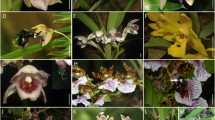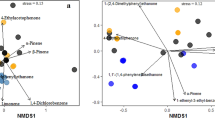Abstract
Volatile organic compounds (VOCs) mediate both mutualistic and antagonistic plant–animal interactions; thus, the attraction of mutualists and antagonists by floral VOCs constitutes an important trade-off in the evolutionary ecology of angiosperms. Here, we evaluate the role of VOCs in mediating communication between the plant and its mutualist and antagonist floral visitors. To assess the evolutionary consequences of VOC-mediated signalling to distinct floral visitors, we studied the reproductive ecology of Dichaea pendula, assessing the effects of florivores on fruit set, the pollination efficiency of pollinators and florivores, the floral scent composition and the attractiveness of the major VOC to pollinators and florivores. The orchid depends entirely on orchid-bees for sexual reproduction, and the major florivores, the weevils, feed on corollas causing self-pollination, triggering abortion of 26.4 % of the flowers. Floral scent was composed of approximately 99 % 2-methoxy-4-vinylphenol, an unusual floral VOC attractive to pollinators and florivores. The low fruit set from natural pollination (5.6 %) compared to hand cross-pollination (45.5 %) and low level of pollinator visitation [0.02 visits (flower hour)−1] represent the limitations to pollination. Our research found that 2-methoxy-4-vinylphenol mediates both mutualistic and antagonistic interactions, which could result in contrary evolutionary pressures on novo-emission. The scarcity of pollinators, not florivory, was the major constraint to fruit set. Our results suggest that, rather than anti-florivory adaptations, adaptations to enhance pollinator attraction and cross-pollination might be the primary drivers of the evolution of VOC emission in euglossine-pollinated flowers.





Similar content being viewed by others
References
Amorim FW, Wyatt GE, Sazima M (2014) Low abundance of long-tongued pollinators leads to pollen limitation in four specialized hawkmoth-pollinated plants in the Atlantic Rain forest, Brazil. Naturwissenschaften 101:893–905. doi:10.1007/s00114-014-1230-y
Andrews ES, Theis N, Adler LS (2007) Pollinator and herbivore attraction to Cucurbita floral volatiles. J Chem Ecol 33:1682–1691. doi:10.1007/s10886-007-9337-7
Baldwin IT, Preston C, Euler M, Gorham D (1997) Patterns and consequences of benzyl acetone floral emissions from Nicotiana attenuata plants. J Chem Ecol 23:2327–2343. doi:10.1023/B:JOEC.0000006677.56380.cd
Barros F, Vinhos F, Rodrigues VT et al (2014) Orchidaceae. In: List. Espécies da Flora do Bras. http://floradobrasil.jbrj.gov.br/2010/FB011488. Accessed 21 Sep 2015
Bronstein JL, Armbruster WS, Thompson JN (2014) Understanding evolution and the complexity of species interactions using orchids as a model system. New Phytol 202:373–375
Cancino ADM, Damon A (2007) Fragrance analysis of euglossine bee pollinated orchids from Soconusco, south-east Mexico. Plant Species Biol 22:129–134. doi:10.1111/j.1442-1984.2007.00185.x
Castro-Arellano I, Lacher TE, Willig MR, Rangel TF (2010) Assessment of assemblage-wide temporal niche segregation using null models. Methods Ecol Evol 1:311–318. doi:10.1111/j.2041-210X.2010.00031.x
Dafni A, Kevan PG, Husband BC (2005) Practical pollination biology. Enviroquest Ltd., Cambridge
Dressler RL (1968) Pollination by Euglossine bees. Evolution (NY) 22:202–210
El-Sayed AM (2012) The Pherobase: database of pheromones and semiochemicals. In: The Pherobase. http://www.pherobase.com. Accessed 12 Mar 2015
Eltz T, Sager A, Lunau K (2005) Juggling with volatiles: exposure of perfumes by displaying male orchid bees. J Comp Physiol A Neuroethol Sensory, Neural, Behav Physiol 191:575–581. doi:10.1007/s00359-005-0603-2
Eltz T, Roubik DW, Lunau K (2006) Experience-dependent choices ensure species-specific fragrance accumulation in male orchid bees. Behav Ecol Sociobiol 59:149–156. doi:10.1007/s00265-005-0021-z
Folsom JP (1985) Pollination floral strategy and pollen flow in Dichaea sp. (Orchidaceae). Am J Bot 72:953–954
Freitas L (2013) Concepts of pollinator performance: is a simple approach necessary to achieve a standardized terminology? Rev Bras Bot. doi:10.1007/s40415-013-0005-6
Gamisch A, Fischer GA, Comes HP (2014) Recurrent polymorphic mating type variation in Madagascan Bulbophyllum species (Orchidaceae) exemplifies a high incidence of auto-pollination in tropical orchids. Bot J Linn Soc 175:242–258
Gunawardena NE, Kern F, Janssen E et al (1998) Host attractants for red weevil, Rhynchophorus ferrugineus: identification, electrophysiological activity, and laboratory bioassay. J Chem Ecol 24:425–437
Janeš D, Kantar D, Kreft S, Prosen H (2009) Identification of buckwheat (Fagopyrum esculentum Moench) aroma compounds with GC-MS. Food Chem 112:120–124. doi:10.1016/j.foodchem.2008.05.048
Johnson SD, Edwards TJ (2000) The structure and function of orchid pollinaria. Plant Syst Evol 222:243–269
Kaiser R (1993) The scent of orchids—olfactory and chemical investigations. Editiones Roche, Basel
Kessler A, Halitschke R, Poveda K (2011) Herbivory-mediated pollinator limitation: negative impacts of induced volatiles on plant-pollinator interactions. Ecology 92:1769–1780. doi:10.1890/10-1945.1
Kessler D, Diezel C, Clark DG et al (2013) Petunia flowers solve the defence/apparency dilemma of pollinator attraction by deploying complex floral blends. Ecol Lett 16:299–306. doi:10.1111/ele.12038
Knudsen JT, Eriksson R, Gershenzon J, Stahl B (2006) Diversity and distribution of floral scent. Bot Rev 72:1–120. doi:10.1663/0006-8101(2006)72
Lima AM da C (1936) Superfamília Curculionoidea. In: Terceiro Catálogo dos Insectos que Vivem nas Plantas do Brasil
Linstrom PJ, Mallard WG (eds) (2011) NIST chemistry webbook, NIST Standard Reference Database Number 69. National Institute of Standards and Technology, Gaithersburg
Marvaldi AE, Sequeira AS, O’Brien CW, Farrell BD (2002) Molecular and morphological phylogenetics of weevils (Coleoptera, Curculionoidea): do niche shifts accompany diversification? Syst Biol 51:761–785. doi:10.1080/10635150290102465
Meléndez-Ackerman EJ, Ackerman JD, Rodríguez-Robles JA (2000) Reproduction in an orchid can be resource-limited over its lifetime. Biotropica 32:282–290
Mickeliunas L, Pansarin ER, Sazima M (2006) Biologia floral, melitofilia e influência de besouros Curculionidae no sucesso reprodutivo de Grobya amherstiae Lindl. (Orchidaceae: Cyrtopodiinae). Rev Bras Botânica 29:251–258
Neiland MRM, Wilcock CC (1998) Fruit set, nectar reward, and rarity in Orchidaceae. Am J Bot 85:1657–1671
Neubig KM, Williams NH, Whitten WM, Pupulin F (2009) Molecular phylogenetics and the evolution of fruit and leaf morphology of Dichaea (Orchidaceae: Zygopetalinae). Ann Bot 3:457–467. doi:10.1093/aob/mcp004
Newstrom LE, Frankie GW, Baker HG (1994) A new classification for plant phenology based on flowering patterns in lowland tropical rain forest trees. Biotropica 26:141–159
Ohashi K, Thomson JD (2009) Trapline foraging by pollinators: its ontogeny, economics and possible consequences for plants. Ann Bot 103:1365–1378. doi:10.1093/aob/mcp088
Pansarin ER, Do Amaral MDCE (2009) Reproductive biology and pollination of southeastern Brazilian Stanhopea Frost ex Hook. (Orchidaceae). Flora Morphol Distrib Funct Ecol Plants 204:238–249. doi:10.1016/j.flora.2008.01.014
Pansarin ER, Bittrich V, Amaral MCE (2006) At daybreak—reproductive biology and isolating mechanisms of Cirrhaea dependens (Orchidaceae). Plant Biol (Stuttg) 8:494–502. doi:10.1055/s-2006-923800
Pérez-Barrales R, Bolstad GH, Pélabon C et al (2013) Pollinators and seed predators generate conflicting selection on Dalechampia blossoms. Oikos 000:001–018. doi:10.1111/j.1600-0706.2013.20780.x
Peter CI, Johnson SD (2009) Reproductive biology of Acrolophia cochlearis (Orchidaceae): estimating rates of cross-pollination in epidendroid orchids. Ann Bot 104:573–581. doi:10.1093/aob/mcn218
Prena J (2008) A synopsis of the orchid weevil genus Orchidophilus Buchanan (Curculionidae, Baridinae), with taxonomic rectifications and description of one new species. Zootaxa 30:18–30
R Development Core Team (2013) R: A language and environment for statistical computing. R Foundation for Statistical Computing, Vienna, Austria
Radford AE, Dickison WC, Massey JR, Bell CR (1974) Vascular plant systematics. Harper and Row, New York
Raguso RA, Thompson JN, Campbell DR (2015) Improving our chemistry: challenges and opportunities in the interdisciplinary study of floral volatiles. Nat Prod Res 00:1–11. doi:10.1039/C4NP00159A
Ramírez SR, Eltz T, Fujiwara MK et al (2011) Asynchronous diversification in a specialized plant-pollinator mutualism. Science (80-) 333:1742. doi:10.1126/science.1209175
Ramírez SR, Hernández C, Link A, López-Uribe MM (2015) Seasonal cycles, phylogenetic assembly, and functional diversity of orchid bee communities. Ecol Evol. doi:10.1002/ece3.1466
Rocha-Filho LC, Krug C, Silva CI, Garófalo CA (2012) Floral resources used by Euglossini bees (Hymenoptera: Apidae) in coastal ecosystems of the Atlantic Forest. Psyche (Stuttg). doi:10.1155/2012/934951
Roubik DW, Ackerman JD (1987) Long-term ecology of euglossine orchid-bees (Apidae: Euglossini) in Panama. Oecologia 73:321–333. doi:10.1007/BF00385247
Schiestl FP (2015) Ecology and evolution of floral volatile-mediated information transfer in plants. New Phytol 206:571–577. doi:10.1111/nph.13243
Schiestl FP, Dötterl S (2012) The evolution of floral scent and olfactory preferences in pollinators: coevolution or pre-existing bias? Evolution (NY) 66:2042–2055. doi:10.1111/j.1558-5646.2012.01593.x
Schiestl FP, Johnson SD (2013) Pollinator-mediated evolution of floral signals. Trends Ecol Evol 28:307–315. doi:10.1016/j.tree.2013.01.019
Schiestl FP, Schlüter PM (2009) Floral isolation, specialized pollination, and pollinator behavior in orchids. Annu Rev Entomol 54:425–446. doi:10.1146/annurev.ento.54.110807.090603
Singer RB, Sazima M (2004) Abelhas Euglossini como polinizadoras de orquídeas na região de Picinguaba, São Paulo, Brasil. In: de Barros F, Kerbauy GB (eds) Orquidologia sul-americana: uma compilação científica. São Paulo, pp 175–187
Sletvold N, Grindeland JM, Ågren J (2010) Pollinator-mediated selection on floral display, spur length and flowering phenology in the deceptive orchid Dactylorhiza lapponica. New Phytol 188:385–392. doi:10.1111/j.1469-8137.2010.03296.x
The Plant List (2010) The plant list. In: Plant list. www.theplantlist.org. Accessed 15 Mar 2015
Theis N, Adler LS (2012) Advertising to the enemy: enhanced floral fragrance increases beetle attraction and reduces plant reproduction. Ecology 93:430–435. doi:10.1890/11-0825.1
Thompson JN (2005) The geographic mosaic theory of coevolution, 1st edn. The University of Chicago Press, Chicago
Thompson JN, Fernandez CC (2006) Temporal dynamics of antagonism and mutualism in a geographically variable plant-insect interaction. Ecology 87:103–112
Trapnell DW, Hamrick JL, Ishibashi CD, Kartzinel TR (2013) Genetic inference of epiphytic orchid colonization; it may only take one. Mol Ecol 22:3680–3692. doi:10.1111/mec.12338
Tremblay RL, Ackerman JD, Zimmerman JK, Calvo RN (2005) Variation in sexual reproduction in orchids and its evolutionary consequences: a spasmodic journey to diversification. Biol J Linn Soc 84:1–54
Uehara-Prado M, Garófalo CA (2006) Small-scale elevational variation in the abundance of Eufriesea violacea (Blanchard) (Hymenoptera: Apidae). Neotrop Entomol 35:446–451
Vale Á, Rojas D, Alvarez JC, Navarro L (2011) Breeding system and factors limiting fruit production in the nectarless orchid Broughtonia lindenii. Plant Biol (Stuttg) 13(Suppl 1):51–61. doi:10.1111/j.1438-8677.2010.00366.x
Veloso HP, Rangel-Filho ALR, Lima JCA (1991) Classificação da vegetação brasileira adaptada a um sistema universal. Fundação Instituto Brasileiro de Geografia e Estatística-IBGE, Rio de Janeiro
Vogel S (1966) Parfümsammelnde vienen als Bestäuber von Orchidaceen und Gloxinia. Österreichische Bot Zeitschrift 113:302–361
Whitten WM, Williams NH, Dressler RL et al (2005) Generic relationships of Zygopetalinae (Orchidaceae: Cymbidieae): combined molecular evidence. Lankesteriana 5:87–107
Williams NH, Whitten WM (1983) Orchid floral fragrances and male Euglossine bees: methods and advances in the last sesquidecade. Biol Bull 164:355–395. doi:10.2307/1541248
Wolowski M, Ashman TL, Freitas L (2014) Meta-analysis of pollen limitation reveals the relevance of pollination generalization in the Atlantic forest of Brazil. PLoS One 9:1–8. doi:10.1371/journal.pone.0089498
Wright GA, Schiestl FP (2009) The evolution of floral scent: the influence of olfactory learning by insect pollinators on the honest signalling of floral rewards. Funct Ecol 23:841–851. doi:10.1111/j.1365-2435.2009.01627.x
Acknowledgments
We thank the Núcleo Santa Virgínia staff, COTEC/IF 41.065/2005and IBAMA/CGEN 093/2005 permits for the logistic help in field work, and MSc. Daniela de Cássia Bená and Prof. Dr. SérgioVanin for identifying the Montella sp. n. weevils. We also thank Arodi and Felipe Goulart Gonçalves for technical support for the laboratory bioassays at ESALQ, and Ludmila M. Pansarin, Jeff Ollerton, Fábio Pinheiro, Felipe Amorim, Kayna Agostini, Alexandre Neutzling and Pietro Kiyoshi Maruyama for the helpful comments on the previous versions of the manuscript. This work was supported by the Conselho Nacional de Desenvolvimento Científico e Tecnológico (Grant nos. 148221/2012-2 to C.E.P.N. and 303084/2011-1 to M.S.) and the National Institute of Science and Technology (INCT) Semiochemicals in Agriculture (CNPq Process 573761/2008-6 and FAPESP Process 2008/57701-2).
Author contribution statement
CEPN conceived the idea for the study. CEPN and MFGVP performed the experiments and analysed the data. CEPN, MFGVP, JMB, MJS and MS discussed the results. CEPN wrote the first draft; CEPN, MFGVP, JMB, MJS and MS contributed to the writing of the manuscript.
Author information
Authors and Affiliations
Corresponding author
Additional information
Communicated by Martin Heil.
In a multidisciplinary and innovative way, this study provides not only basic novel information about the reproductive ecology and pollination mechanism of an orchid but also presents fresh data on the functional chemical ecology of the interaction between the plant and its florivores, providing us with a mechanistic understanding of two plant–animal interactions: pollination and herbivory.
Rights and permissions
About this article
Cite this article
Nunes, C.E.P., Peñaflor, M.F.G.V., Bento, J.M.S. et al. The dilemma of being a fragrant flower: the major floral volatile attracts pollinators and florivores in the euglossine-pollinated orchid Dichaea pendula . Oecologia 182, 933–946 (2016). https://doi.org/10.1007/s00442-016-3703-5
Received:
Accepted:
Published:
Issue Date:
DOI: https://doi.org/10.1007/s00442-016-3703-5




